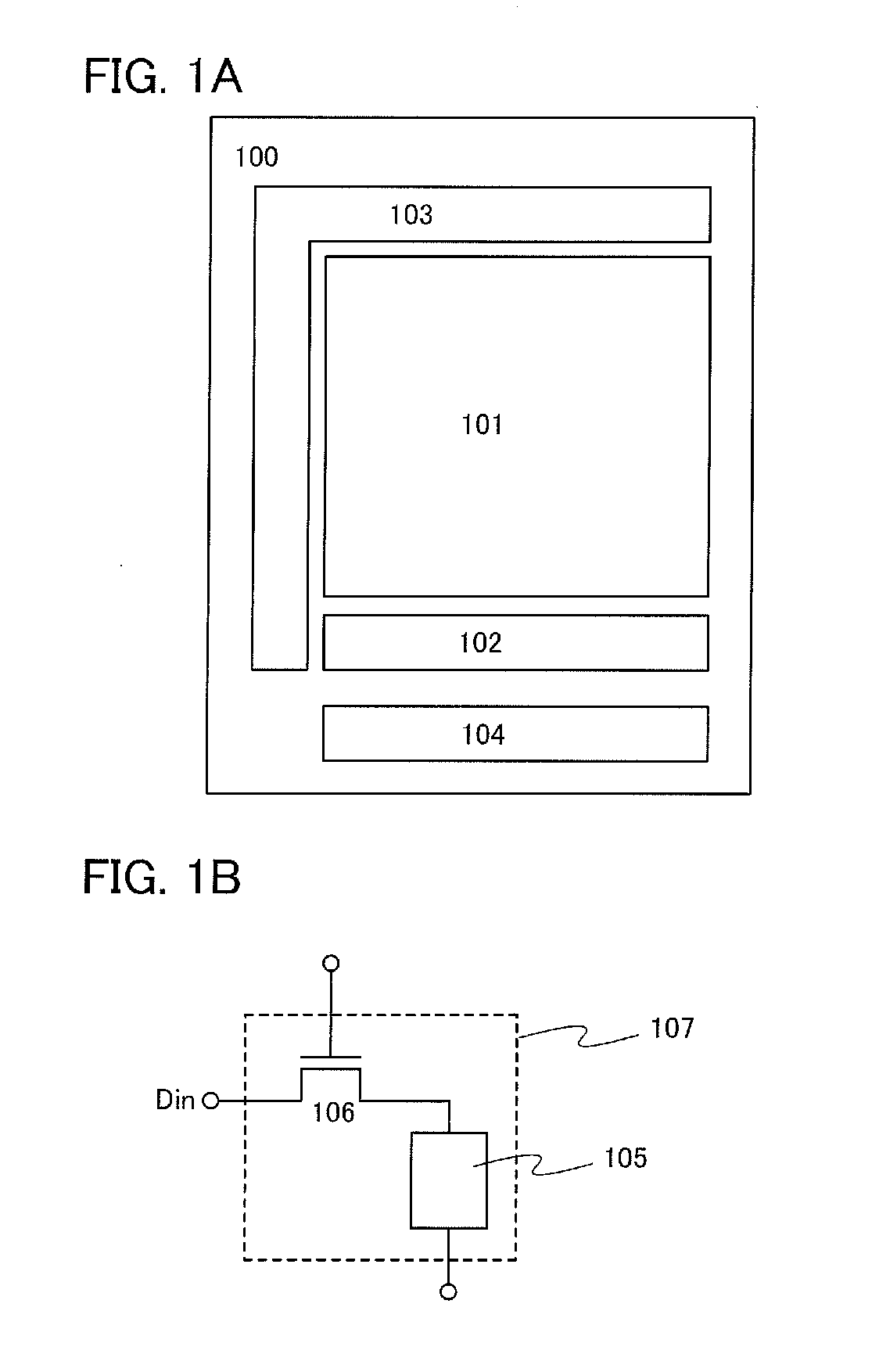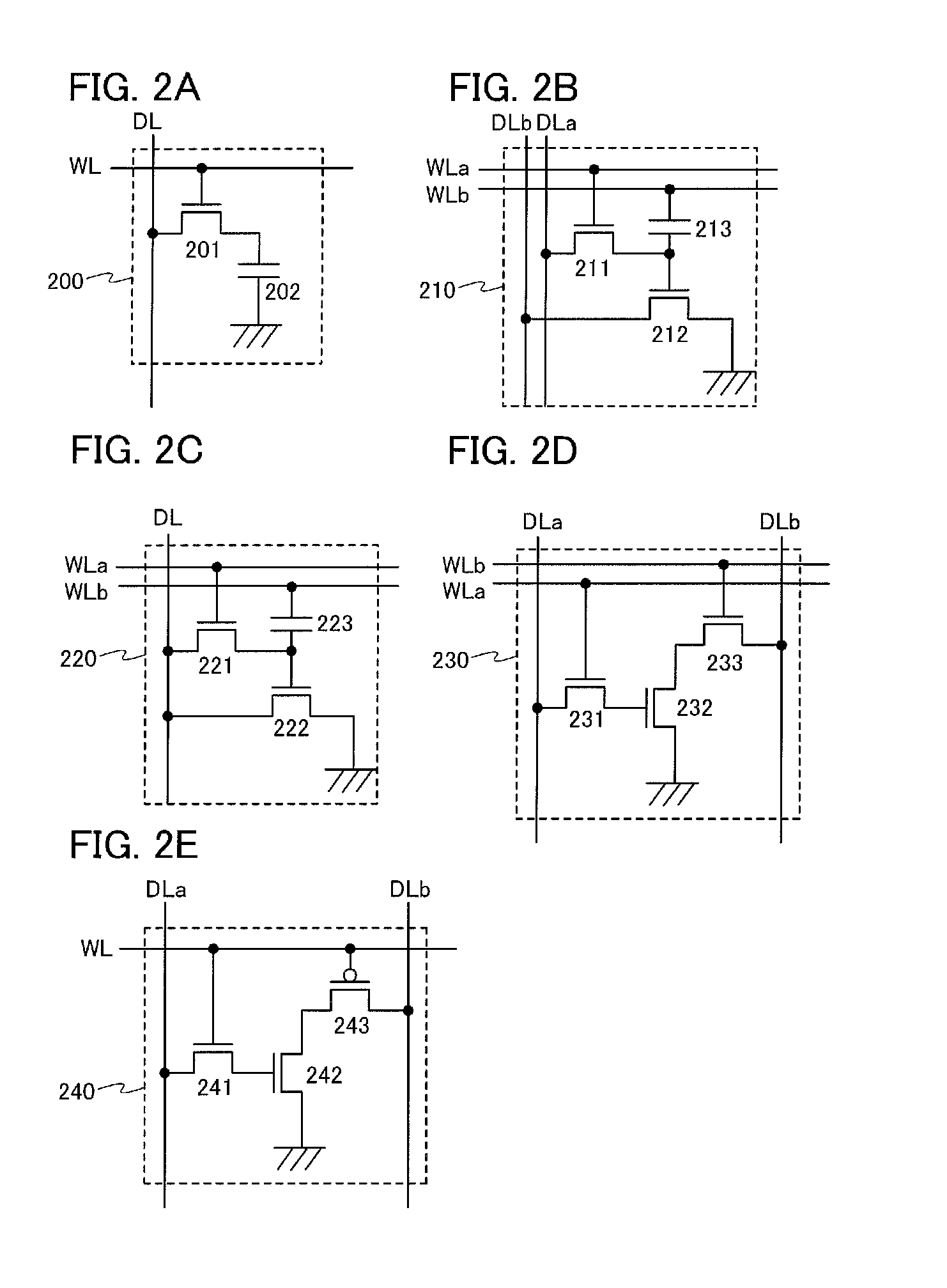Memory device and semiconductor device
a memory device and semiconductor technology, applied in static storage, digital storage, instruments, etc., can solve the problems of data writing, insufficient amount of charge, damage or deformation of memory elements, etc., and achieve the effect of reducing the number of transistors in one memory cell, suppressing power consumption in data writing, and reducing the siz
- Summary
- Abstract
- Description
- Claims
- Application Information
AI Technical Summary
Benefits of technology
Problems solved by technology
Method used
Image
Examples
embodiment 1
[0041]FIG. 1A illustrates a block diagram of a structure of a memory device according to one embodiment of the present invention, as an example. A memory device 100 illustrated in FIG. 1A includes a first memory portion 101, a second memory portion 102, a driver circuit 103, and a comparison circuit 104.
[0042]A plurality of memory cells each including a nonvolatile memory element are provided in the first memory portion 101. Further, a plurality of memory cells each including a memory element and a transistor are provided in the second memory portion 102. The transistor is provided to control the holding of charge in the memory element; the off-state current or the leakage current of the transistor is extremely low.
[0043]The driver circuit 103 controls the operation of the first memory portion 101. Specifically, various kinds of operation such as the writing of data into the first memory portion 101, the reading of data from the first memory portion 101, the holding of data in the f...
embodiment 2
[0111]The operation of the memory device of one embodiment of the present invention is described in more detail.
[0112]In this embodiment, the case where 8-bit data is written into a specified memory region including a plurality of memory cells is given as an example and the operation of the first memory portion is described. FIG. 4 schematically illustrates the flow of data written into the second memory portion in the operation of writing data into the first memory portion, as an example. In FIG. 4, four memory regions included in the second memory portion are used as four data buffers.
[0113]A memory region included in each data buffer has a memory capacity in which data having the same number of bits as data written into the first memory portion can be stored. In this embodiment, each data buffer includes at least a memory region for storing 8-bit data.
[0114]A data buffer for reference data which is shown in FIG. 4 is a data buffer for temporarily storing data (reference data) tra...
embodiment 3
[0144]In this embodiment, a structure of the second memory portion and the operation thereof are described.
[0145]FIG. 6 illustrates an example of the circuit diagram of a second memory portion 205 including a plurality of memory cells 200 one of which is shown in FIG. 2A. For the structure of the memory cell 200, the description in Embodiment 1 can be referred to.
[0146]In the second memory portion 205 shown in FIG. 6, a variety of wirings such as a plurality of word lines WL and a plurality of data lines DL are provided, and a signal or a fixed potential from a driver circuit of the second memory portion 205 is supplied to each memory cell 200 through the wirings. The number of the wirings can be determined by the number of the memory cells 200 and arrangement of the memory cells 200.
[0147]Specifically, the second memory portion 205 shown in FIG. 6 is an example in which memory cells are connected in a matrix with three rows and four columns and word lines WL1 to WL3 and data lines ...
PUM
 Login to View More
Login to View More Abstract
Description
Claims
Application Information
 Login to View More
Login to View More - R&D
- Intellectual Property
- Life Sciences
- Materials
- Tech Scout
- Unparalleled Data Quality
- Higher Quality Content
- 60% Fewer Hallucinations
Browse by: Latest US Patents, China's latest patents, Technical Efficacy Thesaurus, Application Domain, Technology Topic, Popular Technical Reports.
© 2025 PatSnap. All rights reserved.Legal|Privacy policy|Modern Slavery Act Transparency Statement|Sitemap|About US| Contact US: help@patsnap.com



